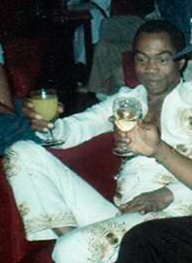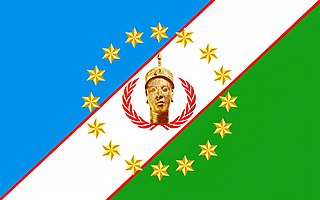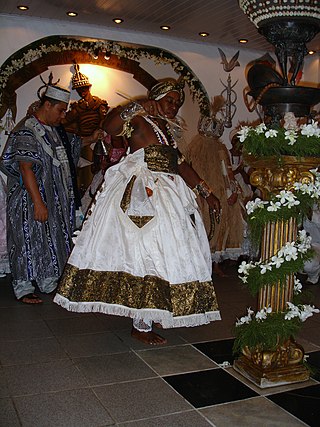
Ayida-Weddo is a powerful loa spirit in Vodou, revered in regions across Africa and the Caribbean, namely in Benin and Haiti. Known as the "Rainbow Serpent", Ayida-Weddo is the loa of fertility, rainbows, wind, water, fire, wealth, thunder, and snakes. Alongside Damballa, Ayida-Weddo is regarded among the most ancient and significant loa, and variants of her name include Ayida, Ayida-Wedo, Aido Quedo, Aido Wedo, Aida Wedo, and Aido Hwedo. Considered in many sources as the female half of Damballa's twin spirit, the names Da Ayida Hwedo, Dan Ayida Hwedo, and Dan Aida Wedo have also been used to refer to her. Thought to have existed before the Earth, Ayida-Weddo assisted the creator goddess Mawu-Lisa in the formation of the world, and is responsible for holding together the Earth and heavens. Ayida-Weddo bestows love and well-being upon her followers, teaching fluidity and the connection between body and spirit.

Shango is an Orisha in Yoruba religion. Genealogically speaking, Shango is a royal ancestor of the Yoruba as he was the third Alaafin of the Oyo Kingdom prior to his posthumous deification. Shango has numerous manifestations, including Airá, Agodo, Afonja, Lubé, and Obomin. He is known for his powerful double axe (Oṣè). He is considered to be one of the most powerful rulers that Yorubaland has ever produced.

Oshun is an orisha, a spirit, a deity, or a goddess that reflects one of the manifestations of the Yorùbá Supreme Being in the Ifá oral tradition and Yoruba-based religions of West Africa. She is one of the most popular and venerated Orishas. Oshun is an important river deity among the Yorùbá people. She is the goddess of divinity, femininity, fertility, beauty, and love. She is connected to destiny and divination.

Oduduwa was a Yoruba divine king, legendary founder of the Ife Empire and a creator deity (orisha) in the Yoruba religion. According to tradition, he was the holder of the title of the Olofin of Ile-Ife, the Yoruba holy city. He ruled briefly in Ife, and also served as the progenitor of a number of independent royal dynasties in Yorubaland.

Fela Aníkúlápó Kútì, also known as Abàmì Ẹ̀dá, was a Nigerian musician, bandleader, composer, political activist, and Pan-Africanist. He is regarded as the King of Afrobeat, a Nigerian music genre that combines West African music with American funk and jazz. At the height of his popularity, he was referred to as one of Africa's most "challenging and charismatic music performers". AllMusic described him as "a musical and sociopolitical voice" of international significance.

Candomblé Ketu is the largest and most influential branch (nation) of Candomblé, a religion practiced primarily in Brazil. The word Candomblé means "ritual dancing or gather in honor of gods" and Ketu is the name of the Ketu region of Benin. Its liturgical language, known as yorubá or Nagô, is a dialect of Yoruba. Candomblé Ketu developed in the early 19th century and gained great importance to Brazilian heritage in the 20th century.
Ifá is a divination system and Yoruba religion that represents the teachings of the Orisha Ọrunmila. which makes use of an extensive corpus of texts and mathematical formulas, is practiced among Yoruba communities and African diaspora in South America and the Caribbean. The word Ifa refers to the mystical figure Ifa or Orunmila, regarded by the Yoruba as the deity of wisdom and intellectual development.

The Yoruba religion, or Isese, comprises the traditional religious and spiritual concepts and practice of the Yoruba people. Its homeland is in present-day Southwestern Nigeria, which comprises the majority of Oyo, Ogun, Osun, Ondo, Ekiti, Kwara and Lagos States, as well as parts of Kogi state and the adjoining parts of Benin and Togo, commonly known as Yorubaland. It shares some parallels with the Vodun practiced by the neighboring Fon and Ewe peoples to the west and with the religion of the Edo people to the east. Yoruba religion is the basis for a number of religions in the New World, notably Santería, Umbanda, Trinidad Orisha, and Candomblé. Yoruba religious beliefs are part of Itàn (history), the total complex of songs, histories, stories, and other cultural concepts which make up the Yoruba society.

Nana Buluku, also known as Nana Buruku, Nana Buku or Nanan-bouclou, is the female supreme being in the West African traditional religion of the Fon people and the Ewe people (Togo). She is one of the most influential deities in West African theology, and one shared by many ethnic groups other than the Fon people, albeit with variations. For example, she is called the Nana Bukuu among the Yoruba people and the Olisabuluwa among Igbo people but described differently, with some actively worshiping her while some do not worship her and worship the gods originating from her.
Ota is a town in Ogun State, Nigeria with an estimated 163,783 residents. Ota is the capital of the Ado–Odo/Ota Local Government Area. The traditional leader of Ota is the Olota of Ota, Oba Adeyemi AbdulKabir Obalanlege. Historically, Ota is the capital of the Awori Yoruba tribe.

The Gẹlẹdẹ spectacle of the Yoruba is a public display by colorful masks which combines art and ritual dance to amuse, educate and inspire worship. Gelede celebrates “Mothers”, a group that includes female ancestors and deities as well as the elderly women of the community, and the power and spiritual capacity these women have in society. Focusing not only on fertility and motherhood but also on correct social behavior within the Yoruba society.
Rodney Stevenson better known by his stage name Islord is a rapper and a member of the hip hop group Killarmy. Although named Rodney Stevenson at birth,he, as all members of Killarmy, is a Five Percenter, and, thus, changed his name legally to Islord. The first three letters of his name: I, S, L, are also the first three letters of "Islam"; in the Five Percent way of life, "Islam" does not represent the religion but "I.S.L.A.M." which is often represented as "I Self Lord And Master." The name Islord is a reiteration of the rapper's assertion of his divinity: "I Self Lord," and a fusion of the terms "Islam" and "lord." Islord is also known as the "Thief of Baghdad." In addition to appearing on Killarmy's albums, Islord appears on two tracks from Bobby Digital in Stereo and the song "Holy Water" from Dom Pachino's Unreleased solo album.
Ọlátúbọ̀sún Oládàpọ̀, also known as Túbọ́sún Ọládàpọ̀, or Odídẹrẹ́ Ayékòótọ́, is a Yoruba-language folk poet, playwright, music producer, radio personality/broadcaster, writer, and researcher from Nigeria whose audience speak Yorùbá and reside chiefly in South-West Nigeria.

The Yoruba of West Africa are responsible for a distinct artistic tradition in Africa, a tradition that remains vital and influential today.
Ìyá Nlá is the primordial spirit of all creation in Yoruba cosmology. She is believed to be the source of all existence. Iya Nla literally means “Great Mother” in the Yoruba language. In The Gẹ̀lẹ̀dẹ́ Spectacle: Art, Gender, and Social Harmony in an African Culture, art historian Babatunde Lawal reveals that Ìyá Nlá in Yoruba cosmology is the orisha who is the “Mother of All Things, including the deities.” Lawal also asserts that the female principle in nature has been personified as Ìyá Nlá, whereby human beings can relate to one another as children of the same mother.” Teresa N. Washington’s Our Mothers, Our Powers, Our Texts: Manifestations of Àjẹ́ in Africana Literature, states that Ìyá Nlá — the Mother of All, who is also known as Yewájọbí, Odù, Odùduwà, and Àjẹ́ — is not merely an orisha; Ìyá Nlá is the primordial force of all creation.

The Yoruba people are a West African ethnic group who mainly inhabit parts of Nigeria, Benin, and Togo. The areas of these countries primarily inhabited by the Yoruba are often collectively referred to as Yorubaland. The Yoruba constitute more than 44 million people in Africa, are over a million outside the continent, and bear further representation among members of the African diaspora. The vast majority of the Yoruba population is today within the country of Nigeria, where they make up 15.5% of the country's population according to CIA estimations, making them one of the largest ethnic groups in Africa. Most Yoruba people speak the Yoruba language, which is the Niger-Congo language with the largest number of native or L1 speakers.

Trinidad Orisha, also known as Orisha religion and Shango, is a syncretic religion in Trinidad and Tobago and the Caribbean, originally from West Africa. Trinidad Orisha incorporates elements of Spiritual Baptism, and the closeness between Orisha and Spiritual Baptism has led to use of the term "Shango Baptist" to refer to members of either or both religions. Anthropologist James Houk described Trinidad Orisha as an "Afro-American religious complex", incorporating elements mainly of traditional African religion and Yoruba and incorporates some elements of Christianity, Hinduism, Islam, Buddhism, Judaism, Baháʼí, and Amerindian mythologies.

Oshunmare is an Orisha. Osumare is the spirit of the rainbow, and Osumare also means rainbow in the Yoruba language.
Iyalawo is a term in the Lucumi religion that literally means Mother of Mysteries or Mother of Wisdom. Some adherents use the term "Mamalawo," which is a partially African diaspora version of the Lucumi term, Iyaláwo and Yeyelawo are two more versions of mother of mysteries. Ìyánífá is a Yoruba word that can be translated as Mother (Ìyá) has or of (ní) Ifá or Mother in Ifá & is the Yoruba title for Mother of mysteries & the female equivalent of a Babalawo.
Teresa N. Washington is an African American academic, author, activist, and public speaker. She is known for her research on Àjẹ́, a Yorùbá term that defines both a spiritual power inherent in Africana women and the persons who have that power. Washington's book Our Mothers, Our Powers, Our Texts: Manifestations of Àjẹ́ in Africana Literature is the first comprehensive book-length study of Àjẹ́. Her book The Architects of Existence: Àjẹ́ in Yoruba Cosmology, Ontology, and Orature gives an in-depth analysis of the power of Àjẹ́ in the Yorùbá ethos and worldview.













